Ditapis dengan

Food Vs. Food Stamps: Evidence from an At-Scale Experiment In Indonesia
Governments seeking to provide food assistance have a choice between providing in-kind food directly to beneficiaries, or providing vouchers that can be used to purchase food on the market. To understand the differences between these policies, the Government of Indonesia randomly phased in the transition from in-kind delivery of subsidized rice to approximately equivalent vouchers usable to buy…
- Edisi
- Working Paper 60-e - 2021
- ISBN/ISSN
- 977 2746857002
- Deskripsi Fisik
- PDF, 50 Halaman
- Judul Seri
- Working Paper
- No. Panggil
- 363.8 BAN f
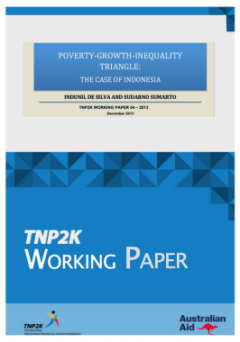
Poverty-Growth-Inequality Triangle: The Case of Indonesia
This paper decomposes changes in poverty into growth and redistribution components, and employs several pro-poor growth concepts and indices to explore the growth, poverty and inequality nexus in Indonesia over the period 2002-2012. We find a ‘trickle-down’ situation, which the poor have received proportionately less benefits from growth than the non-poor. All pro-poor measures suggest that…
- Edisi
- TNP2K Working Paper 04 – 2013
- ISBN/ISSN
- -
- Deskripsi Fisik
- PDF, 41 Halaman
- Judul Seri
- Textbook dan Working Paper
- No. Panggil
- 362.509598 SIL p
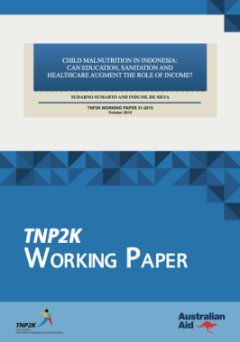
Child Malnutrition in Indonesia: Can Education, Sanitation and Healthcare Aug…
In spite of sustained economic growth and progress in poverty reduction, the status of child nutrition in Indonesia is abysmal, with chronic malnutrition rates continuing to remain at very high levels. In this backdrop, this study attempts to shed light on the channels through which various socioeconomic risk factors affect children’s nutritional status in Indonesia. We investigated the impac…
- Edisi
- TNP2K Working Paper 31-2015
- ISBN/ISSN
- -
- Deskripsi Fisik
- PDF, 51 Halaman
- Judul Seri
- Textbook dan Working Paper
- No. Panggil
- 362.196914 SUM c
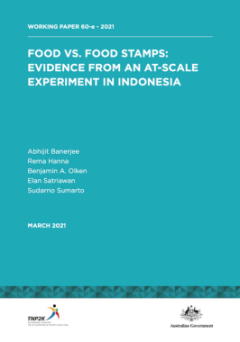
Food Vs. Food Stamps: Evidence From an At-Scale Experiment in Indonesia
Governments seeking to provide food assistance have a choice between providing in-kind food directly to beneficiaries, or providing vouchers that can be used to purchase food on the market. To understand the differences between these policies, the Government of Indonesia randomly phased in the transition from in-kind delivery of subsidized rice to approximately equivalent vouchers usable to buy…
- Edisi
- Vol 03/No. 01-03- June 2022
- ISBN/ISSN
- 977 2746857002
- Deskripsi Fisik
- PDF, 244 Halaman
- Judul Seri
- Textbook dan Working Paper
- No. Panggil
- 300.5 BAN f
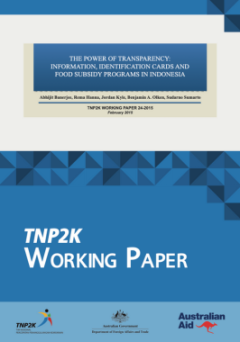
The Power of Transparency: Information, Identification Cards and Food Subsidy…
Can governments improve aid programs by providing information to beneficiaries? In our model, information can change how much aid citizens receive as they bargain with local officials who implement national programs. In a large-scale field experiment, we test whether mailing cards with program information to beneficiaries increases their subsidy from a subsidized rice program. Beneficiaries rec…
- Edisi
- TNP2K Working Paper 24-2015
- ISBN/ISSN
- -
- Deskripsi Fisik
- vii, 44 Halaman, PDF
- Judul Seri
- Working Paper
- No. Panggil
- 363.809598 BAN t
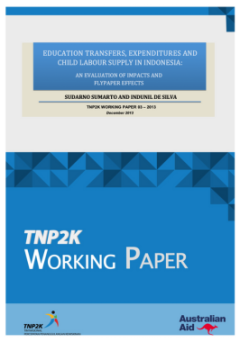
Education Transfers, Expenditures and Child Labour Supply in Indonesia: an Ev…
In this paper we investigate how the receipt of educational transfers, scholarships and related assistance programmes affects the labour supply of children and the marginal spending behaviour of households on children’s educational goods. We use a nationally representative household survey of unusual scope and richness from Indonesia. We found strong evidence of educational cash transfers and…
- Edisi
- TNP2K Working Paper 03 – 2013
- ISBN/ISSN
- -
- Deskripsi Fisik
- PDF, 51 Halaman
- Judul Seri
- Textbook dan Working Paper
- No. Panggil
- 379.509598 SUM e
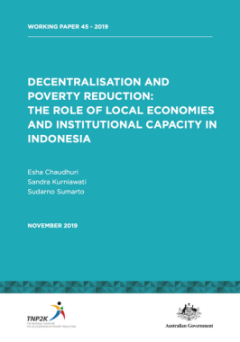
Decentralisation and Poverty Reduction: The Role of Local Economies and Insti…
Over the two decades to 2019, a decentralised Indonesia has made significant progress in reducing the poverty rate by more than 50 percent. Despite a significant decline at the national level, progress in poverty reduction has been uneven across districts. This study aims to investigate those factors that may explain these regional variations using panel regressions. Using district panel data s…
- Edisi
- Working Paper 45 - 2019
- ISBN/ISSN
- -
- Deskripsi Fisik
- PDF, 40 Halaman
- Judul Seri
- Textbook dan Working Paper
- No. Panggil
- 363.509598 CHA d
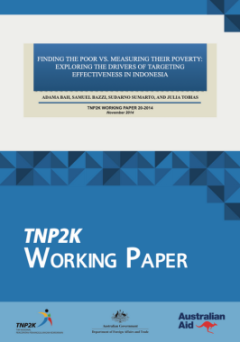
Finding The Poor Vs. Measuring Their Poverty: Exploring The Drivers of Target…
Centralised targeting registries are increasingly used to allocate social assistance benefits in developing countries. This paper provides the first attempt to identify the relative importance of two key design issues for targeting accuracy: (1) which households to survey for inclusion in the targeting registry and (2) how to rank surveyed households. We evaluate the performance of Indonesia’…
- Edisi
- TNP2K Working Paper 20-2014
- ISBN/ISSN
- -
- Deskripsi Fisik
- PDF, 36 Halaman
- Judul Seri
- Textbook dan Working Paper
- No. Panggil
- 362.509598 BAH f
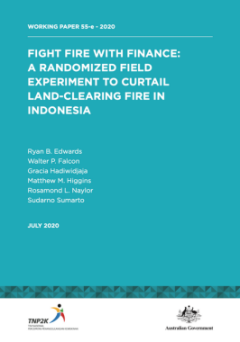
Fight Fire with Finance: a Randomized Field Experiment to Curtail Land-Cleari…
This paper presents one of the first randomized evaluations of collective pay-for-performance payments for ecosystem services. We test whether community-level fiscal incentives can curtail the use of land-clearing fire, a major source of emissions and negative health externalities. The program was implemented over the 2018 fire season in Indonesia with three parts: (a) awareness raising and…
- Edisi
- Working Paper 55-e - 2020
- ISBN/ISSN
- -
- Deskripsi Fisik
- PDF, 64 Halaman
- Judul Seri
- Textbook dan Working Paper
- No. Panggil
- 363.3709598 EDW f
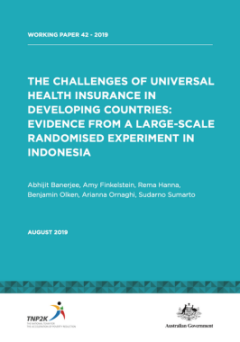
The Challenges of Universal Health Insurance in Developing Countries: Evidenc…
To assess ways to achieve widespread, financially sustainable health insurance coverage in developing countries, we designed a randomised experiment involving almost 6,000 households in Indonesia who are subject to a nationally mandated government health insurance program (Jaminan Kesehatan Nasional: JKN). We assessed several interventions that simple theory and prior evidence suggest could inc…
- Edisi
- Working Paper 42 - 2019
- ISBN/ISSN
- -
- Deskripsi Fisik
- 42 Halaman, PDF
- Judul Seri
- Working Paper
- No. Panggil
- 368.38209598 BAN t
 Karya Umum
Karya Umum  Filsafat
Filsafat  Agama
Agama  Ilmu-ilmu Sosial
Ilmu-ilmu Sosial  Bahasa
Bahasa  Ilmu-ilmu Murni
Ilmu-ilmu Murni  Ilmu-ilmu Terapan
Ilmu-ilmu Terapan  Kesenian, Hiburan, dan Olahraga
Kesenian, Hiburan, dan Olahraga  Kesusastraan
Kesusastraan  Geografi dan Sejarah
Geografi dan Sejarah